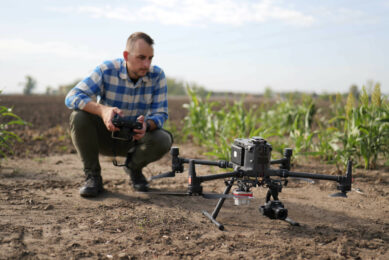Hungarian drone technology gaining credibility in crop spraying

Aside from their original intended use in the military, drones are now becoming extremely popular in the agricultural industry as crop spraying technology. Their appeal is creating high demand to such an extent industry sources say the agricultural drone market is increasing by around 24% per year and could be worth US$ 5.62 billion by 2027.
Investors are now queuing up to get in on the action for an industry that is aiming to radically reduce emissions, both in terms of pesticides used and carbon produced.
ABZ Innovation is based in Hungary and has developed a number of drones suitable for spraying vineyards and agricultural crops, the biggest of which is the new L30 model fitted with a 30l tank. The company’s smaller L10 model with 10l tank has proved very popular to date for smaller spraying applications.
Text continues below picture

Transformative application
Developed and tested in partnership with the University of Gyor, ABZ Innovation says its agricultural drones ‘represent a transformative application of drone technology, providing a cost-effective and highly efficient means of field and orchard spraying.’ Karoly Ludvigh, ABZ Innovation chief executive, outlined the company’s goals and explained why their drones are successful.
“Firstly, we want to make spraying more efficient and our drones can do that by spot spraying, using less pesticides and water. Our drones can achieve 40 percent increase in crop coverage using up to 50 percent less chemicals and 90 percent less water.” One of the main advantages of the drone is that it can reach areas of land that perhaps were inaccessible before, such like steep or wet areas.
Text continues below picture

Downward motion
ABZ builds its own drones in Hungary sourcing the parts it needs both locally and abroad. Karoly added: “Our advanced CDA spraying system, coupled with highly optimised airflow from the propellers, sets our drones apart. The propellers create a downward motion for the spray droplets, which are smaller than those used in hydraulic spraying.
“This downward flow hits the target more efficiently and at the same time reduces operating costs. “Not only do we offer exceptional efficiency, but our enhanced power train extends the life of our drones’ batteries, ensuring the lowest possible operating costs.”
Text continues below picture

21 hectares per hour
The accuracy of spraying with ABZ drones is high, at within 1.5mm, and is a valuable asset in keeping input and water costs down. With a 30l payload on the L30 model, the company advice is that the power from one 25000mAh battery will allow for the spraying of one hectare.
Karoly suggests his biggest L30 drone is suitable for a farm with 80 to 100 hectares of crops and has the capacity to spray up to 21 hectares per hour.
They use a four battery system where one is in the drone, while at the same time another is charging and two are resting. Depending on the use the batteries are expected to have 200 to 1,000 charge cycles. Karoly says 90 percent of the drone’s operating costs derive from the batteries, hence the four battery pack use system.
Flight control for the L10 is via a triple-redundant IMU, has centimetre-level RTK accuracy and an EMLID RTK base station optional for L10 PRO model.
Text continues below picture

Training for drone pilots
The modular structure L10 drones have adjustable working widths and a maximum flow rate of 4.8l per minute, while the L30 can achieve up to 16l per minute. The spraying system has a brushless pump and impellers as well as a three-stage filter system.
The company offers training for drone pilots and farmers to get them used to the technology and also offers a comprehensive backup service for technical advice and spare parts.
Text continues below video
Join 17,000+ subscribers
Subscribe to our newsletter to stay updated about all the need-to-know content in the agricultural sector, two times a week.



